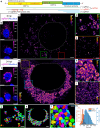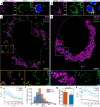Nanoscale cellular organization of viral RNA and proteins in SARS-CoV-2 replication organelles
- PMID: 38821943
- PMCID: PMC11143195
- DOI: 10.1038/s41467-024-48991-x
Nanoscale cellular organization of viral RNA and proteins in SARS-CoV-2 replication organelles
Abstract
The SARS-CoV-2 viral infection transforms host cells and produces special organelles in many ways, and we focus on the replication organelles, the sites of replication of viral genomic RNA (vgRNA). To date, the precise cellular localization of key RNA molecules and replication intermediates has been elusive in electron microscopy studies. We use super-resolution fluorescence microscopy and specific labeling to reveal the nanoscopic organization of replication organelles that contain numerous vgRNA molecules along with the replication enzymes and clusters of viral double-stranded RNA (dsRNA). We show that the replication organelles are organized differently at early and late stages of infection. Surprisingly, vgRNA accumulates into distinct globular clusters in the cytoplasmic perinuclear region, which grow and accommodate more vgRNA molecules as infection time increases. The localization of endoplasmic reticulum (ER) markers and nsp3 (a component of the double-membrane vesicle, DMV) at the periphery of the vgRNA clusters suggests that replication organelles are encapsulated into DMVs, which have membranes derived from the host ER. These organelles merge into larger vesicle packets as infection advances. Precise co-imaging of the nanoscale cellular organization of vgRNA, dsRNA, and viral proteins in replication organelles of SARS-CoV-2 may inform therapeutic approaches that target viral replication and associated processes.
© 2024. The Author(s).
Conflict of interest statement
The authors declare no competing interests.
Figures






Update of
-
Nanoscale cellular organization of viral RNA and proteins in SARS-CoV-2 replication organelles.bioRxiv [Preprint]. 2024 Apr 1:2023.11.07.566110. doi: 10.1101/2023.11.07.566110. bioRxiv. 2024. Update in: Nat Commun. 2024 May 31;15(1):4644. doi: 10.1038/s41467-024-48991-x. PMID: 37986994 Free PMC article. Updated. Preprint.
References
MeSH terms
Substances
Grants and funding
- R35 GM118067/GM/NIGMS NIH HHS/United States
- R35-GM118067/U.S. Department of Health & Human Services | NIH | National Institute of General Medical Sciences (NIGMS)
- R35GM118067/U.S. Department of Health & Human Services | NIH | National Institute of General Medical Sciences (NIGMS)
- U01 DK127405/DK/NIDDK NIH HHS/United States
- U01-DK127405/U.S. Department of Health & Human Services | National Institutes of Health (NIH)
LinkOut - more resources
Full Text Sources
Research Materials
Miscellaneous

